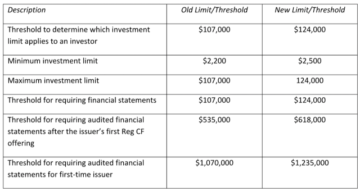
Lots of people have asked for a legal explanation in response to my previous post about crowdfunding vehicles and the series LLC. Plus, many funding portals will want a Written Supervisory Procedure (WSP) addressing the issue.
Here’s the legal reason why a “series” of a limited liability company can’t serve as a crowdfunding vehicle.
Rule 3a-9(b)(1) (17 CFR §270.3a-9(b)(2)) defines “crowdfunding vehicle” as follows:
Crowdfunding vehicle means an issuer formed by or on behalf of a crowdfunding issuer for the purpose of conducting an offering under section 4(a)(6) of the Securities Act as a co-issuer with the crowdfunding issuer, which offering is controlled by the crowdfunding issuer.
You see the reference to the crowdfunding vehicle as an “issuer” and a “co-issuer.”
Now here’s a C&DI (Compliance & Disclosure Interpretation) issued by the SEC in 2009:
Question 104.01
Question: When a statutory trust registers the offer and sale of beneficial units in multiple series, or a limited partnership registers the offer and sale of limited partnership interests in multiple series, on a single registration statement, should each series be treated as a separate registrant?
Answer: No. Even though a series of beneficial units or limited partnership interests may represent interests in a separate or discrete set of assets – and not in the statutory trust or limited partnership as a whole – unless the series is a separate legal entity, it cannot be a co-registrant for Securities Act or Exchange Act purposes.
Note the conclusion: “. . . .unless the series is a separate legal entity, it cannot be a co-registrant for Securities Act or Exchange Act purposes.”
A “series” of a limited liability company is not a separate legal entity. Under section 218 of the Delaware Limited Liability Company Act and corresponding provisions of the LLC laws of other states, if you keep accurate records then the assets of one series aren’t subject to the liabilities of another series. That makes a series like a separate entity, at least in one respect, but it doesn’t make the series a separate legal entity. A motorcycle is like a car in some respects but it’s not a car.
That’s the beginning and end of the story: a crowdfunding vehicle must be an “issuer”; a series of a limited liability company can’t be an “issuer” because it’s not a separate legal entity; therefore a series of a limited liability company can’t be a crowdfunding vehicle.
Maybe someone will challenge the application of the C&DI in court. Until that happens the result is pretty clear.
A couple more things.
First, this same C&DI is the basis of many successful offerings under Regulation A. Suppose, for example, that you’d like to use Regulation A to raise money for real estate projects (or racehorses, or vintage cars, or anything else), but you don’t want to spend the time and money to conduct a Regulation A offering for each project. This same C&DI allows sponsors to treat the “parent” limited liability company as the only “issuer” in the Regulation A offering even while allowing investors to choose which project they’d like to invest in and segregating the projects in separate “series” for liability purposes. If each series were a separate issuer that wouldn’t work.
Second, suppose a funding portal creates a new series for each offering and has conducted 25 offerings (that is, 25 series for 25 crowdfunding vehicles), each with a different type of security (one for each offering). Because we know that only the “parent” can be an issuer:
- They’ve violated Rule 3a-9(a)(3) because the parent has issued more than one class of securities; and
- They’ve violated Rule 3a-9(a)(6) because there is no one-to-one correspondence between the securities of the parent and the securities of the crowdfunding issuer.
To quote Simon & Garfunkel, any way you look at this you lose.
If you’re a funding portal, you’ll probably be asked by FINRA to add a WSP dealing with crowdfunding vehicles. Here’s an example.
Questions? Let me know.
- SEO Powered Content & PR Distribution. Get Amplified Today.
- EVM Finance. Unified Interface for Decentralized Finance. Access Here.
- Quantum Media Group. IR/PR Amplified. Access Here.
- PlatoAiStream. Web3 Data Intelligence. Knowledge Amplified. Access Here.
- Source: https://crowdfundingattorney.com/2023/06/20/the-series-llc-and-crowdfunding-vehicle-a-legal-explanation-and-a-funding-portal-wsp/
- :has
- :is
- :not
- 1
- 17
- 25
- a
- accurate
- Act
- add
- addressing
- Allowing
- allows
- an
- and
- Another
- any
- anything
- Application
- AS
- Assets
- At
- basis
- BE
- because
- Beginning
- behalf
- beneficial
- between
- Blog
- but
- by
- CAN
- cannot
- car
- cars
- challenge
- Choose
- class
- clear
- company
- compliance
- conclusion
- Conduct
- conducted
- conducting
- controlled
- Corresponding
- Couple
- Court
- creates
- Crowdfunding
- dealing
- Defines
- Delaware
- different
- disclosure
- Doesn’t
- Dont
- each
- else
- end
- entity
- estate
- Ether (ETH)
- Even
- example
- exchange
- explanation
- fintech
- follows
- For
- formed
- funding
- happens
- Have
- HTTPS
- if
- in
- interests
- interpretation
- Invest
- Investors
- issue
- Issued
- Issuer
- IT
- jpg
- Keep
- Know
- Law
- Laws
- least
- Legal
- legal entity
- liabilities
- liability
- like
- Limited
- LLC
- Look
- lose
- make
- MAKES
- many
- May..
- me
- means
- money
- more
- motorcycle
- multiple
- must
- my
- New
- no
- of
- offer
- offering
- Offerings
- on
- ONE
- only
- or
- Other
- Partnership
- People
- plato
- Plato Data Intelligence
- PlatoData
- plus
- Portal
- Post
- pretty
- probably
- procedure
- project
- projects
- purpose
- purposes
- quote
- raise
- real
- real estate
- reason
- records
- registers
- Registration
- Regulation
- represent
- respect
- response
- result
- Rule
- sale
- same
- SEC
- Section
- Securities
- security
- see
- separate
- Series
- Series A
- serve
- set
- should
- Simon
- single
- some
- Someone
- spend
- Sponsors
- Statement
- States
- Story
- subject
- successful
- than
- that
- The
- The Projects
- then
- There.
- therefore
- things
- this
- though?
- time
- to
- treat
- treated
- Trust
- type
- under
- units
- until
- use
- vehicle
- Vehicles
- vintage
- violated
- want
- Way..
- we
- were
- when
- which
- while
- whole
- why
- will
- with
- Work
- written
- you
- zephyrnet









